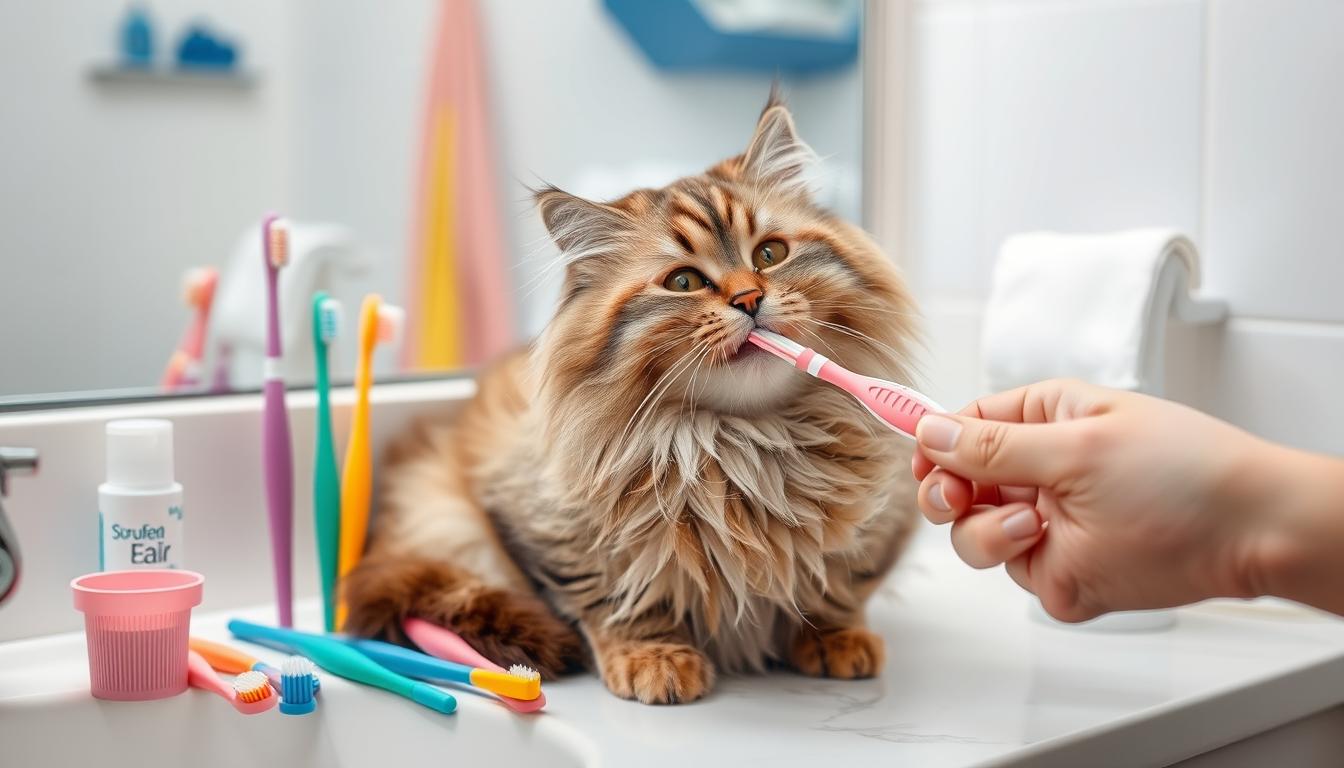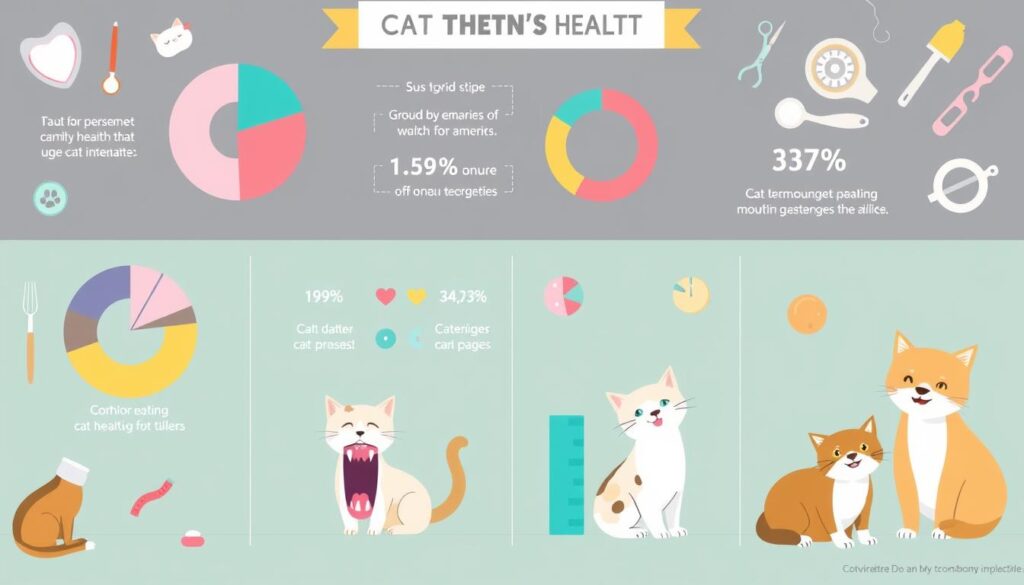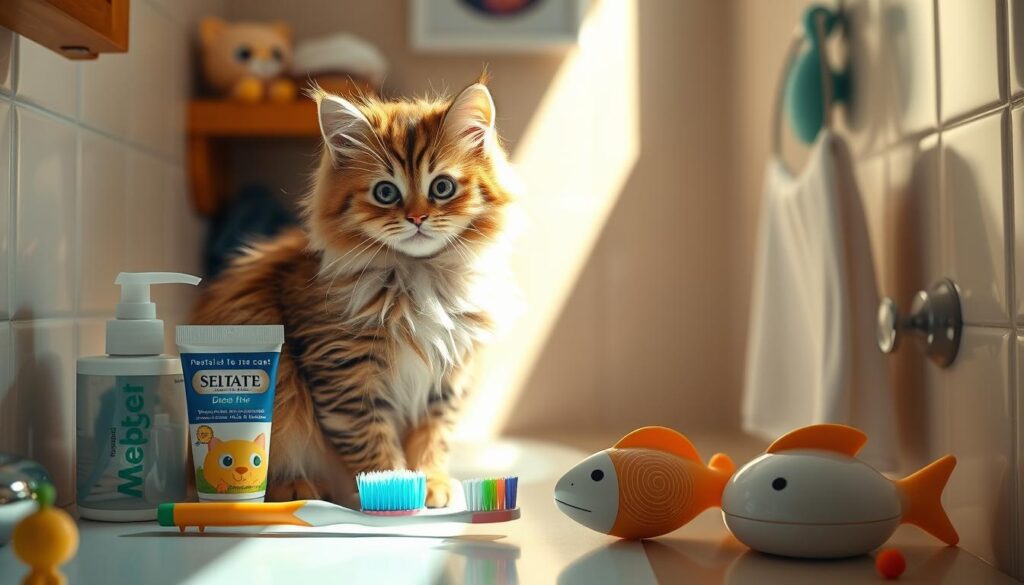As a devoted cat parent, I know how vital it is to keep your feline friend’s teeth and gums healthy. Sadly, up to 70% of cats develop periodontal disease by 2 years old without proper dental care. That’s why I’m here to share my personal experience and guide you on how to start brushing your cat’s teeth.
Brushing your cat’s teeth might seem daunting, but it’s a simple and effective way to prevent plaque buildup, tartar formation, bad breath, and even more serious health issues like gum inflammation and tooth loss. By starting this routine early, you can help your cat maintain optimal oral hygiene and overall well-being.
Key Takeaways
- Regular brushing is crucial to prevent dental diseases in cats
- Start brushing your kitten’s teeth as soon as they are weaned
- Brush your cat’s teeth daily or every other day to remove plaque before it hardens into tartar
- Use a pet-specific toothbrush and toothpaste to make the experience comfortable for your cat
- Be patient and use positive reinforcement when training your cat to accept brushing
Understanding Cat Dental Health Statistics
Keeping your cat’s teeth clean is very important. Sadly, many cats face dental problems. Dental disease affects 50% to 90% of cats over the age of four. Feline Tooth Resorption, a serious issue, hits nearly 75% of cats over five.
But, many cat owners ignore their pets’ dental care. Shockingly, 73% of cat parents don’t brush their cat’s teeth at all. Brushing your cat’s teeth weekly can stop plaque and tartar buildup.
Prevalence of Periodontal Disease in Cats
Periodontal disease is common, with up to 75% of cats over the age of five suffering from advanced periodontal disease. This can cause tooth loss and harm overall health if not treated.
Impact of Poor Dental Hygiene
Ignoring your cat’s dental health can be very harmful. Chronic, untreated dental disease in cats can lead to the spread of infection and inflammation beyond the mouth, affecting the heart, kidneys, and liver. Regular dental exams and cleanings are key to your cat’s health.
Current Pet Owner Brushing Habits
Vets say to brush your cat’s teeth two to three times a week. This helps prevent tartar, gingivitis, and periodontal disease. Yet, with more than half of cats over three years old showing dental disease signs, many owners are not doing enough.
| Dental Issue | Prevalence |
|---|---|
| Dental disease in cats over 4 years old | 50% to 90% |
| Feline Tooth Resorption in cats over 5 years old | Close to 75% |
| Cats with advanced periodontal disease over 5 years old | Up to 75% |
| Cat parents who don’t brush their cat’s teeth | 73% |
The Importance of Regular Dental Care for Cats
Regular dental care is key for your cat’s health. It stops periodontal disease, which can hurt, make eating hard, and cause infections. Brushing their teeth keeps bad breath, swollen gums, and tooth loss away. Healthy teeth and gums are vital, as bad dental health can harm their heart and kidneys.
Experts say cats need dental cleanings every 1-2 years. More often for those with dental problems. Brushing daily or 2-3 times a week is best. Regular dental visits and care catch problems early.
Ignoring dental care leads to plaque, gingivitis, and disease. Signs include bad breath, swollen gums, less appetite, and behavior changes. By focusing on cat dental care and preventive vet care, your cat stays healthy and happy.
“Consistent brushing of a cat’s teeth a few times a week can significantly reduce the risk of dental issues.”
Start dental care early, after weaning. Positive reinforcement like treats or praise helps. Regular cat dental care means your cat will have a healthy mouth all their life.
| Dental Issue | Impact |
|---|---|
| Gingivitis | Inflammation of the gums |
| Tooth Resorption | Gradual loss of tooth structure |
| Stomatitis | Inflammation of soft mouth tissues |
| Tooth Fractures | Broken or cracked teeth |
| Oral Tumors | Abnormal cell growth in the mouth |
| Halitosis | Chronic bad breath |
Essential Tools and Supplies for Cat Teeth Cleaning
Keeping your cat’s teeth clean is important. You need the right tools and supplies. This includes picking the right cat toothbrush and safe cat toothpaste.
Selecting the Right Cat Toothbrush
Choose a small, soft-bristled toothbrush made for cats. These brushes fit well in your cat’s mouth and are gentle. Finger brushes are also good for a gentle clean.
Choosing Safe Cat Toothpaste
Don’t use human toothpaste on your cat. It can harm them with fluoride, detergents, and xylitol. Instead, use cat toothpaste in flavors like poultry, beef, or seafood. Enzymatic toothpaste is best for removing plaque and tartar.
Additional Dental Care Tools
- Dental wipes: Convenient for a quick clean between brushings
- Water additives: Help reduce plaque and tartar buildup
- Dental treats: Can supplement your cat’s oral hygiene routine
Using a toothbrush and other dental care tools regularly is key. It helps prevent problems like gingivitis and periodontal disease.
Brushing Your Cat’s Teeth: Step-by-Step Guide
Keeping your cat’s teeth clean is important for their health. Start by making them comfortable with having their mouth touched. Then, introduce the cat teeth brushing steps slowly.
- Begin by gently touching your cat’s lips and gums to familiarize them with the sensation.
- Slowly introduce the toothbrush and toothpaste, letting your cat sniff and explore the new items at their own pace.
- Start with short brushing sessions, focusing on the outer surfaces of the teeth, especially near the gumline. Aim for 30-second sessions, gradually increasing the time as your cat becomes more comfortable.
- Use gentle circular motions and work your way from the front teeth towards the back molars, ensuring you cover all surfaces.
- Brush your cat’s teeth daily or every other day for the best results. Consistency is key to establishing a positive routine.
Remember, patience and positive reinforcement are essential when brushing your cat’s teeth. Offering treats and praise can help create a pleasant association with the experience. With time and practice, your feline companion will learn to tolerate and even enjoy their dental care routine.
“Cats respond well to routine, and they may benefit from having their teeth brushed at the same time every day, making them easier to work with.”
By following these cat teeth brushing technique steps, you can help maintain your cat’s dental health and prevent costly veterinary interventions down the line. Consistent feline dental care steps are the key to a happy, healthy smile for your furry friend.
Training Your Cat to Accept Tooth Brushing
Teaching your cat to get used to tooth brushing can be tough. But, with patience and positive feedback, you can do it. It’s all about making the environment calm and creating good feelings around the process.
Creating Positive Associations
Begin by linking tooth brushing to treats and praise. Give your cat a tasty reward right after brushing. This shows them it’s a good thing. Slowly make the brushing time longer, letting your cat decide how much they want.
Gradual Introduction Techniques
First, let your cat get used to the toothbrush and toothpaste on their own. Let them sniff and explore, then give them a treat. This step helps them feel more comfortable with the tools and the brushing.
Reward-Based Training Methods
Use treats or playtime as rewards for good brushing sessions. This makes them look forward to it. Be patient and let your cat control the pace. Stop if they seem upset to keep it a good experience.
With time and effort, your cat will learn to like tooth brushing. This is great for their cat dental health and overall health. Adding these pet grooming techniques to their routine can prevent dental problems and keep their smile bright.
Common Challenges and Solutions in Cat Dental Care
Keeping your cat’s teeth clean is tough, but it’s crucial for their health. Many pet owners struggle with cat dental problems and feline teeth cleaning issues.
Cats often don’t like their mouths touched, making tooth brushing hard. To solve this, start slowly and use treats to make it fun.
- Begin by lightly touching your cat’s mouth and teeth, giving them treats and praise.
- Gradually introduce the toothbrush, letting your cat get used to it.
- Use a soft toothbrush and toothpaste safe for pets to make it easier.
Keeping up with dental care can also be a challenge. Cats like routine, so any changes can upset them. Brush their teeth at the same time every day to make it a routine they can follow.
| Challenge | Solution |
|---|---|
| Cat Resistance | Gradual Introduction, Positive Reinforcement |
| Difficulty Reaching Back Teeth | Appropriate Tools, Patience |
| Maintaining Consistent Routine | Establish a Routine, Make it Positive |
If tooth brushing is still a no-go, try dental wipes or water additives. These can help with cat dental problems and feline teeth cleaning issues. Check your cat’s teeth for tartar and bad breath often. If you see problems, take them to the vet.
Being patient and consistent is important for cat dental care. With time and the right approach, your cat can learn to enjoy tooth brushing.
Professional Dental Care and Veterinary Support
Brushing your cat’s teeth at home is key for their oral health. But, sometimes, they need a vet’s help. Look for professional cleaning if you see tartar or dental disease signs. Also, yearly dental check-ups with your vet are a must to keep their teeth and gums healthy.
When to Seek Professional Cleaning
Even with regular brushing, some cats need a vet’s cleaning for serious dental issues. This is true for older cats or those with dental problems. A vet can remove tartar and plaque and check for other oral health issues.
Signs of Dental Problems
- Bad breath
- Difficulty eating or chewing
- Pawing at the mouth
- Visible tartar or inflamed gums
If you see these signs, get a vet appointment for a dental check and cleaning if needed. Dental problems can get worse, leading to gingivitis, periodontitis, and tooth loss.
Working with your vet and adding veterinary dental care to your cat’s health plan is key. This way, their teeth and gums stay healthy for life.
| Dental Care Service | Average Cost |
|---|---|
| Professional Dental Cleaning at Vet | $325 |
| Dental Prescription Food (3kg bag) | $0.75 per day |
Professional teeth cleaning and care can be expensive. But, regular brushing at home is cheaper. Still, getting vet help when needed is vital for your cat’s health.
Alternative Dental Care Methods and Products
While regular tooth brushing is the most effective way to maintain your cat’s dental health, there are alternative methods and products that can help. These can complement or even substitute for brushing, especially if your feline friend is resistant to the process.
Dental wipes are a popular option. They help remove plaque and freshen your cat’s breath. These wipes are gently wiped across the teeth and gums, providing a convenient alternative to brushing.
Water additives are another useful tool for cat dental care. When added to your cat’s drinking water, these solutions help reduce harmful bacteria in the mouth. This contributes to overall oral hygiene.
- VOHC-approved water additives, like the all-natural option, can effectively control bacteria and freshen breath.
Dental treats and dental-specific cat foods are also designed to promote mechanical cleaning of your cat’s teeth. While not as thorough as brushing, these products can still play a role in maintaining your cat’s dental health.
| Product | How it Works | VOHC Approval |
|---|---|---|
| Enzymatic Toothpaste | Breaks down plaque and prevents tartar formation | Yes |
| Water Additive for Cats | Helps control bacteria in the mouth | Yes |
| VOHC-Approved Dental Treats | Mechanical plaque and tartar removal | Yes |
While not as effective as regular brushing, these alternative methods and products can be valuable. They support your cat’s overall dental health, especially for those felines who are resistant to the toothbrush.
“Regular check-ups and cleanings are crucial for early detection and prevention of dental problems in cats.”
By incorporating a combination of brushing, dental treats, and other approved products, you can help keep your cat’s teeth and gums healthy. This helps prevent painful issues and promotes their overall well-being.
Conclusion
Keeping your cat’s mouth healthy is key to their happiness. Brushing their teeth daily is the best way to stop dental problems. Start early, be patient, and use treats to make it fun.
Don’t rely only on treats or special diets for dental care. Brushing is the main thing. It keeps your cat’s mouth healthy and pain-free for years.
By focusing on cat oral health and regular dental care, you’ll make your pet’s life better. It’s worth the effort to avoid big health issues and expensive vet bills later.



